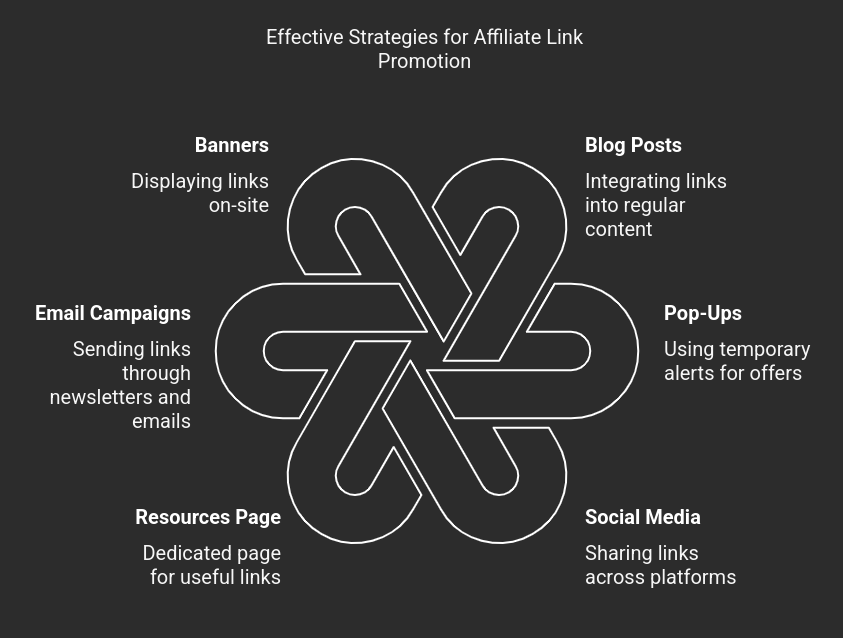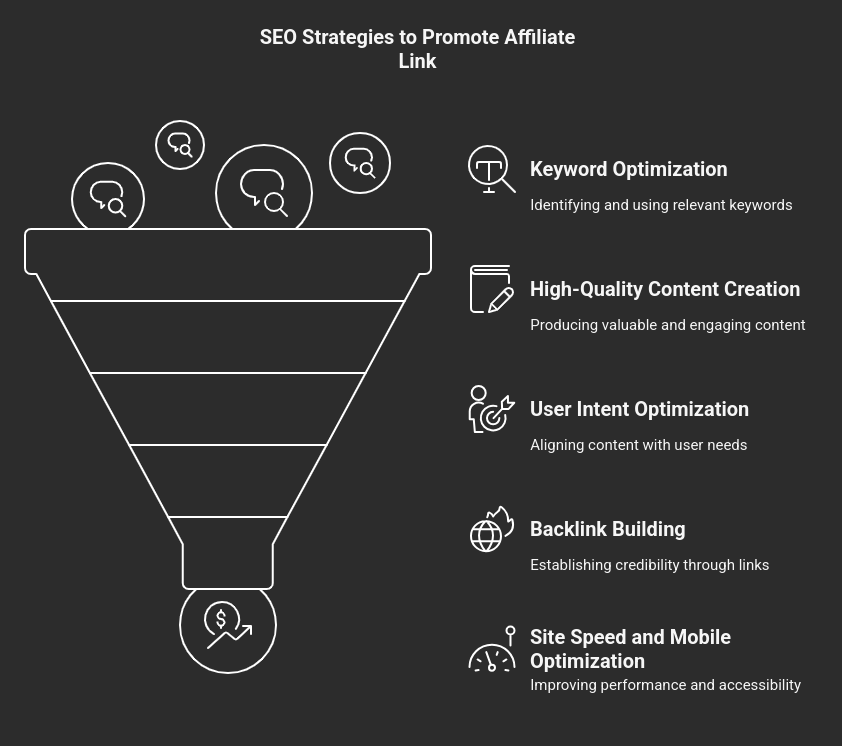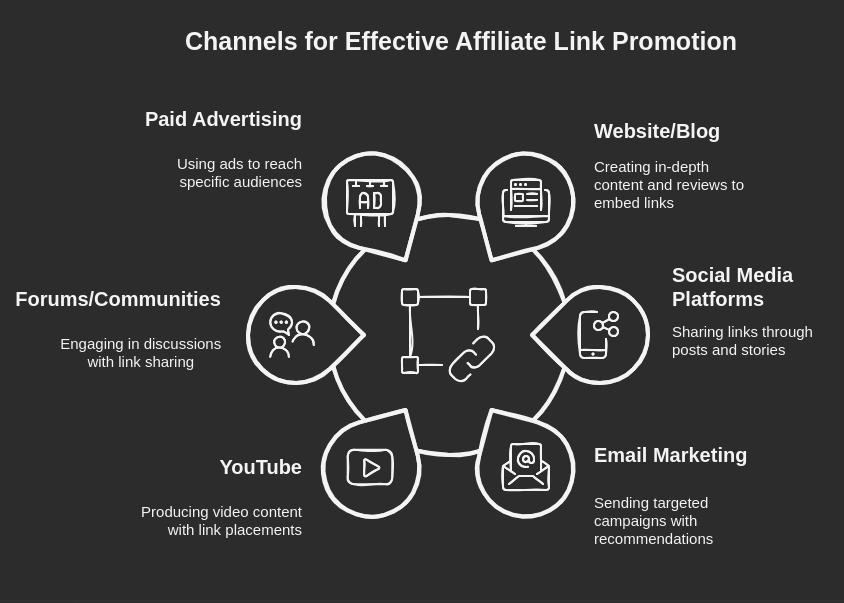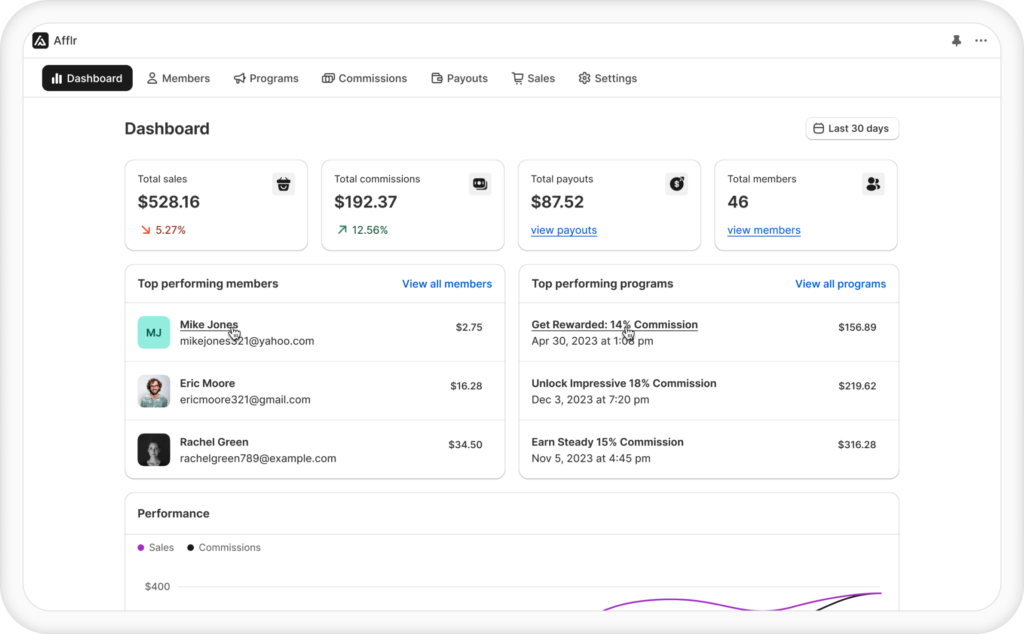Promoting Affiliate links increases your store’s reach. Most people throw affiliate links into blogs, emails, and product pages, nothing wrong with that. But what if I told you there are smarter ways to place them that drive even better conversions?
In this blog, I have shared seven effective ways how to market affiliate links so that you get in touch with more people without making things overly complicated. Let’s go learn!
Simplify Your workflow with automated affiliate link tracking and reduced manual effort with Afflr.
What are Affiliate links?
Affiliate links are special URLs used by affiliates to earn a commission when they sell products or services. When someone clicks on an affiliate link and buys something, the affiliate will be provided a commission based on the sale made. Store owners create affiliate links and provide them to their affiliates for them to promote. For those starting with Affiliate marketing, affiliate links can be more useful in promoting their products.
These links often operate under affiliate commission models, such as pay-per-sale, pay-per-click, or pay-per-lead, to ensure affiliates are rewarded fairly for their efforts. Businesses provide these links to affiliates to help promote their products, and the affiliates earn money based on their results. It is a simple system that benefits both parties.
How can promoting affiliate links help your Shopify store?
Promoting affiliate links can significantly help your Shopify store in terms of increasing sales and reach. As people share the affiliate links, they are essentially bringing your products to new markets, which would bring more traffic to your store. This would be tapping into markets you would not have reached on your own.
- Cost-Effective Marketing: You pay only for sales made, and that too on commission, saving the advertising costs.
- Brand Awareness: Affiliates introduce your brand to their followers, increasing the visibility of your brand.
- Trusted Recommendations: Recommendations from trusted affiliates improve credibility and encourage purchases.
- Drive Targeted Traffic: Affiliates are good at bringing you highly interested traffic, which means higher conversion rates.
Use Afflr to get access to customizable affiliate links and increase your clicks.
Top 7 ways to promote an Affiliate link
Affiliate links can help store owners like you increase sales and expand your reach. After researching a few blogs and websites, I have found the top 7 ways in which you can promote your affiliate link. I have listed them below;
- Add Affiliate Links to Blog Posts
- Use Pop-Ups to Promote Offers
- Share Links on Social Media
- Create a Resources Page
- Promote Email Campaigns
- Use Banners on Your Site
- Share Affiliate Links in FAQs

1. Add Affiliate Links to Blog Posts
Adding affiliate links to your blog posts is a strong way to market products while bringing value to the reader. Here’s why and how it does it:
- Educate and Engage Readers: Blog posts are a good avenue to explain to readers in great detail the value of the product.
- Boost Credibility: Including affiliate links in informative, well-written content builds trust and encourages clicks.
- Optimize SEO: Search-optimized blog posts can rank higher in search engines, thereby driving organic traffic to your affiliate links.
Placement Tips:
- Link organically in the relevant section of your blog.
- Use phrases such as “Learn more here” or “Check it out now” as a call to action to encourage clicks.
- Highlight the benefits of the product so that the link is appealing.
This is where you strategically place affiliate links within your blog posts, thereby turning valuable content into a steady source of income.
2. Use Pop-Ups to Promote Offers
Pop-ups are a great way to attract the attention of your audience and promote affiliate links. Here’s how they can help:
- Instant Visibility: Pop-ups will appear right on the screen, so visitors are sure to notice your affiliate offers.
- Targeted Messaging: Use pop-ups to show relevant products or discounts based on user behavior. You can use the Shopify pop-up apps to set up pop-ups for your store.
- Boost Conversions: Highlight limited-time deals or exclusive affiliate discounts to create urgency and encourage clicks.
Tips for Effective Pop-Ups
- The message must be clear and concise.
- The design should be catchy but consistent with the branding of your site.
- It should not be intrusive by appearing at an appropriate time when the user scrolls a percentage of the page.
If done properly, pop-ups can increase clicks on affiliate links and generate more sales without creating an interruption for the user.
3. Share Links on Social Media
Affiliate links can be easily promoted through social media for a wider reach. Here is how it could be done:
- Reach a wider audience: Mostly, for Instagram, Twitter, and Facebook, users can get direct access to wider followers so that they can click on your affiliate links and get rewarded instantly.
- Engage Followers: Engage people through reviews about products, successful stories, or product tutorials highlighting the advantages of the associated products. You can use the Shopify product review app, which can seamlessly integrate with your Shopify store.
- Visual appeal: Use pictures videos or infographics to make posts more visible so that more people click on affiliate links.
- Encourage Sharing: Followers are more likely to share posts if they find value in the content, thereby enabling you to reach even further.
Tips for effective Social media promotion:
- The use of relevant hashtags increases the chance that people can discover them.
- Post regularly but do not spam. Balance affiliate content with other engaging posts.
- Track your performance to see which types of posts drive the most clicks and conversions.
By using social media, you can create a consistent flow of traffic to your affiliate offers, boosting your sales potential.
4. Create a Resources Page
A resources page is a section on your website where you can list and promote your affiliate products. Here’s why it’s good:
- Centralized Hub: It gives visitors a one-stop place to find all your recommended tools and products, making it easy for them to make purchases through your affiliate links.
- Builds Trust: A well-curated resources page shows that you’re providing valuable, handpicked recommendations rather than just pushing random affiliate products.
- Boosts Conversion Rates: Since your audience knows they can trust your recommendations, they are more likely to click on your affiliate links and make purchases.
Tips for a Successful Resources Page:
- Include brief descriptions or reviews of each product to explain why they’re valuable.
- Add affiliate disclaimers to ensure transparency and maintain trust.
- Maintain the page updated with new and relevant recommendations.
A resources page is a long-term asset that continually brings in affiliate revenue while offering genuine value to your audience.
5. Promote Email Campaigns
Email campaigns are the most direct and personal way of sharing affiliate links with your audience. Affiliate email examples can help you attract new affiliates to your store. Here is how they help:
- Targeted Promotion: With segmented email lists, you can send offers to specific groups based on their interests or past behavior, thereby increasing the chance of a conversion.
- Build Relationships: Email allows you to nurture your audience by providing valuable content along with affiliate offers, which increases trust and boosts credibility.
- Drive Instant Action: In contrast, emails cause instant action since they arrive right into subscribers’ mailboxes, giving more chances at link clicks from affiliates.
Effective Email Campaign Tips:
- Use catchy subject lines and make the recipient open up the email.
- Include a mix of helpful content (e.g., guides, reviews) and promotions to avoid coming off as too sales-focused.
- Track open rates and click-through rates to optimize your future campaigns.
With the right strategy, email campaigns can be a consistent and high-converting method for promoting affiliate links to your most engaged audience. Hence Affiliate email marketing can also do wonders.
6. Use Banners on Your Site
Banners are great for visually marketing affiliate links, and thus getting traffic to particular products or offers. Here is how they work:
- Increased Visibility: Banners are very noticeable. They make the best ways of showing affiliate products to your visitors who come to your site.
- Grab Attention: Through good designs, banners attract people’s attention, hence encouraging users to click as they go through your website.
- Easy Integration: You can place banners in very visible positions like your homepage, sidebar, or at the top of blog posts to ensure maximum exposure.
Tips for Effective Banner Usage:
- Design banners that are consistent with your website’s aesthetic but still stand out to capture attention.
- Use strong calls to action like “Shop Now” or “Exclusive Offer Inside” to increase engagement.
- Keep banners simple and focused, too much information can overwhelm visitors and reduce clicks.
- Test various banner sizes and placements to determine which ones result in the most affiliate link conversions.
Banners are a non-intrusive means of promoting affiliate offers while at the same time improving the user experience on your website, making them a valuable source of revenue generation. You can use the Shopify banner slider app, which can integrate easily with your Shopify store.
7. Share Affiliate Links in FAQs
It’s possible to integrate affiliate links subtly yet effectively within the FAQ section. Here is how it will help:
- Answer User Questions: FAQs give straight answers to common questions, and you can include affiliate links where appropriate to recommend useful products or services.
- Natural Integration: By suggesting affiliate products as part of a helpful answer, the links appear less promotional and more like a valuable resource.
- Improves the user experience: Providing products as answers to queries can lead users to solutions that may not have even occurred to them, thus improving their entire experience.
Tips for sharing affiliate links through FAQs:
- Do not clutter your FAQ section with affiliate links, just ensure it stays relevant and helpful.
- Add context, such as, “We recommend this tool because it helps us with our [specific need].”
- It is very crucial to add clear disclaimers that the links are affiliates so that a user will come to know before clicking on those links.
When you share an affiliate link, strategically placed throughout your FAQs, you also provide value and create another kind of passive income without ever inconveniencing the user’s experience.
SEO Strategies to Promote an Affiliate Link
To optimize your website and its content for search engines and thus, create organic traffic around the affiliate link, we use SEO methods to promote affiliate links better. Here’s how to do it by using SEO strategies.
Keyword Optimization:
- Research Relevant Keywords: To get high-volume keywords, use tools such as Google Keyword Planner or SEMrush, giving keywords related to your products in the affiliate link.
- Use Long-Tail Keywords: Target long-tail keywords that are more specific and less competitive, bringing in more qualified traffic to your affiliate links.
- Optimize On-Page SEO: Include your keywords naturally in titles, headers, meta descriptions, and throughout the content to help promote affiliate links organically.
Create High-Quality Content:
- Write Detailed Reviews: Write in-depth product reviews or comparison articles that provide value and strategically promote affiliate links.
- Evergreen Content: Produce evergreen content that continually drives traffic and clicks on affiliate links.
Optimize for User Intent:
- Content and Search Intent: Ensure that your content is in line with what users are searching for; be it a product recommendation, review, or solution that contains an affiliate link.
- Engaging Content: Incorporate engaging features like images, videos, or infographics that help enhance user experience and push for more clicks on your affiliate links.
Build Backlinks:
- Guest Posting: Create guest posts for renowned blogs and place affiliate links whenever it’s applicable; thus, pushing your affiliate links to new audiences.
- Build Shareable Content: Create high-quality content that others will want to share and link back to improve your site’s authority and visibility for your affiliate links.
Optimize Your Site Speed and Mobile Experience:
- Optimize for Fast Loading Times: A fast website improves the experience of users’ interaction and consequently, their search rankings. The user will likely click on and engage with your affiliate links.
- Ensure Mobile Responsiveness: Since a majority of people are accessing the website through their mobile, it is essential to fully optimize the site to market affiliate links more effectively on mobile.
This is how SEO can help drive more organic traffic and hence market affiliate links effectively to earn a commission.

Best Channels to Promote Affiliate Link
Promote your affiliate links through various channels to reach diverse audiences and increase conversions. I have found a few channels that can help you promote your affiliate links. Here’s the best place to promote affiliate links effectively:
Your Website/Blog
- The primary advantage of a blog or a website is that you can create in-depth content, reviews, and recommendations which might naturally throw in affiliate links.
- Content marketing like tutorials, case studies, and product roundups can be super useful for promoting affiliate links on your site.
Social Media Platforms:
- Instagram: Share the link in posts, Stories, or via your bio link for product images.
- Facebook: Use updates, groups, and Facebook ads for affiliate links. Facebook affiliate marketing can be a good choice to promote affiliate links.
- Twitter: Share information around affiliate links especially of offers with limited time duration.
- Pinterest: Pin product images that are addressed with an affiliate link. Useful niches for this sort of activity are fashion, beauty, and home.
- TikTok: Use short videos with affiliate links displayed on your profile or in the video description.
Email:
- Targeted affiliate campaigns with offers, product reviews, and recommendations can be sent, thus promoting affiliate links naturally.
- Include affiliate links in newsletters or welcome sequences to build trust and drive conversions.
YouTube:
- Video content like reviews, unboxings, and tutorials can be created, providing value while promoting affiliate links in the video description or during the video itself.
- Affiliate links can be used in pinned comments for more visibility.
Forums and Communities:
- Join niche forums, Reddit threads, or specialized Facebook groups where affiliate links are allowed. Identify highly profitable and high-earning niches to promote your brand.
- Provide helpful answers and subtly include affiliate links that align with the conversation.
Paid Advertising:
- Use Google Ads, Facebook Ads, or Pinterest Ads to drive traffic to affiliate links.
- Paid campaigns can target highly specific audiences, helping to effectively promote affiliate links.
Podcasting:
- If you have a podcast, promote affiliate links in your episodes or show notes, offering discounts or exclusive deals for your listeners.
- By using a mix of these channels, you can effectively promote affiliate links, reaching a wider audience and increasing conversions for your affiliate offers.

Mistakes to avoid while promoting affiliate links
After knowing how affiliate links can be placed on websites, I have also found what not to do with them. There are a few things that you as store owners should keep in mind for better results for your store.
- Overloading Content with Affiliate Links: Avoid placing many affiliate links in one post. Focus on value, and put links organically.
- Lack of Transparency: Always declare what you’re promoting as an affiliate link to gain the trust of your audience.
- Promoting Irrelevant Products: Don’t promote affiliate links to products that do not align with your audience’s interests.
- Not tracking performance: You can’t see which affiliate links work without tracking. Use analytics to measure results.
- Ignoring SEO: Failing to optimize for SEO can reduce traffic to your affiliate links. Your content should rank well.
Effortlessly create affiliate links and track your affiliate performance easily with Afflr.
Conclusion
In this blog, you have learned how to promote affiliate links, SEO strategies, channels to promote, and the mistakes that you have to avoid while promoting affiliate links. These strategies and insights can help you drive more sales and boost your ROI. Implement these ideas and experience your Shopify store’s growth.
Further Reading
- Best Shopify Affiliate Marketing Apps 2025: Compared & Reviewed
- Shopify Affiliate Marketing – Complete Guide for 2025
- 10 Best Shopify Ads Apps to Grow Traffic
- How to Create an Affiliate Program in Your Shopify Store
Frequenty Asked Questions:
Affiliate links can be promoted on a blog, with social media, email campaigns, YouTube videos, and even paid advertisements. However, an affiliate must focus on creating valuable content where they naturally incorporate affiliate links to click and convert. Pop-ups, banners, and dedicated landing pages further increase visibility.
Specifically, the number of followers is not relevant for promulgating affiliate links. Nonetheless, a quality following of active users, on social media, a blog, or an email list, can exponentially increase your possibility of generating sales and earning commissions. The number of followers is irrelevant; it is, instead the loyal and trusting audience that matters most.
An affiliate marketing link contains a code that is a unique tracking source. When, for example, a person purchases something after clicking on the marketer’s link, the commission is earned by this affiliate. As the link works to track sales and attribute sales to the source, it accurately reports and remains transparent in calculating earnings for everyone involved.
An affiliate link is used basically to track a customer’s referral. This will help in rewarding an affiliate with a commission once his link leads to a sale or conversion. It enables businesses to expand their reach through affiliates while providing a performance-based earning model for marketers.
